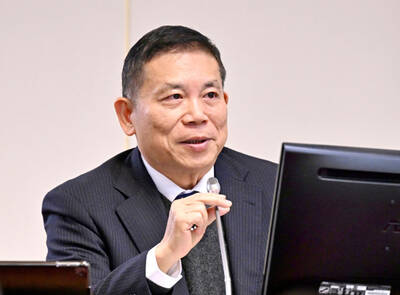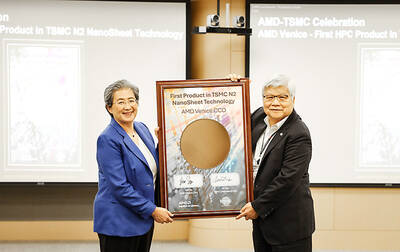You know times have changed when French wines, bruised by competition from the “New World,” fight back with the upstarts’ own weapon — dropping complex regional labeling for the plain old grape name.
Even the staunchest of Gallic wine lovers now order chardonnay or cabernet sauvignon instead of, say, their favorite Chablis or Bordeaux.
The change concerns everyday wines, notably those bound for export.
Labels on better varieties, grand cru and AOC or “controlled designation of origin” wines will carry on in time-honored fashion.
But it’s a jolt in a country where regional identity remains strong (are you from Brittany? Provence?), where the term terroir — soil — is an agricultural mark of pride and where wines can be declined down to the hillside where the grapes grew.
CONSISTENCY
The strategy? Market recognition, consistent taste.
“It’s like creating a well-known brand name, like Apple or Coca-Cola,” said Valerie Pajotin, director of Anivin, a trade organization formed last year to promote Vin de France, the new denomination that has replaced the old vin de table, or table wine, a term that carried a negative connotation of low quality.
The goal? Winning back ground from “New World” competitors, notably Californian and Australian wines that overtook French sales in some key foreign markets like Britain, Germany and the US.
“In one generation, we lost 20 to 30 percent of the share of our principal markets,” said Bertrand Praz, purchasing manager for Grands Chais de France, which bills itself as the leading French exporter of wines and spirts.
Last year alone, exports of French wine tumbled 19 percent to 5.5 billion euros (US$6.7 billion), dropping to levels of a decade ago, according to figures from Ubifrance, the French agency for international business development.
Some critics feel the change could damage local wine traditions, but Praz insists that French growers need “to be more humble and rethink how they work.”
Historically, place has been primordial, even in everyday wines. French producers relied on their reputation for quality and savoir-faire and did not worry about making labels understandable to the uninitiated, he said.
Add to this vintage — good years and bad years — to confuse the choice.
In came “New World” wines, starting several decades ago with the US, Australia, New Zealand and South Africa, and more recently Chile and Argentina, who wooed away clients with user-friendly labels touting the grape name.
GRAPE VARIETY KEY
“You can no longer ignore the fact that grape variety is now the undisputed reference” for consumers trying out wines, Anivin president Rene Moreno said.
The client will ask for a “sauvignon” if he wants a dry white wine or a “chardonnay” if he prefers one that’s full-bodied, he said.
Chris Adams, chief executive of the major Manhattan retailer Sherry Lehmann (SL), said he thought the changes could help French sales in the US.
“It’s been a long time in coming and there is some ground to be made,” he said.
“Newer world varietal wines are starting to lose a bit of traction, and I think what we term ‘French country’ wines here at SL can gain some ground with this move,” he said.
Wine trade sources say the new labeling could also boost domestic sales, notably in supermarket chains and with younger clients.
The new approach was helped by 2008 reforms in the EU wine sector that allowed use of the generic term Vin de France.
“The goal is to simplify French offerings based on a label, a taste, a national origin, with a consistent quality, the way New World countries do,” Moreno said.
The reforms allow producers to mix the same grape variety from different regions to “allow more creativity and to adapt easier to market demands,” said Pajotin, whose Anivin group has an annual 800,000 euro budget.
“This possibility of mixing ensures a consistent quality wanted by the consumer who is expecting the same taste from January 1 to December 31,” she said.
Like Coca-Cola.

Taiwan will prioritize the development of silicon photonics by taking advantage of its strength in the semiconductor industry to build another shield to protect the local economy, National Development Council (NDC) Minister Paul Liu (劉鏡清) said yesterday. Speaking at a meeting of the legislature’s Economics Committee, Liu said Taiwan already has the artificial intelligence (AI) industry as a shield, after the semiconductor industry, to safeguard the country, and is looking at new unique fields to build more economic shields. While Taiwan will further strengthen its existing shields, over the longer term, the country is determined to focus on such potential segments as

UNCERTAINTY: Innolux activated a stringent supply chain management mechanism, as it did during the COVID-19 pandemic, to ensure optimal inventory levels for customers Flat-panel display makers AUO Corp (友達) and Innolux Corp (群創) yesterday said that about 12 to 20 percent of their display business is at risk of potential US tariffs and that they would relocate production or shipment destinations to mitigate the levies’ effects. US tariffs would have a direct impact of US$200 million on AUO’s revenue, company chairman Paul Peng (彭雙浪) told reporters on the sidelines of the Touch Taiwan trade show in Taipei yesterday. That would make up about 12 percent of the company’s overall revenue. To cope with the tariff uncertainty, AUO plans to allocate its production to manufacturing facilities in

COLLABORATION: Given Taiwan’s key position in global supply chains, the US firm is discussing strategies with local partners and clients to deal with global uncertainties Advanced Micro Devices Inc (AMD) yesterday said it is meeting with local ecosystem partners, including Taiwan Semiconductor Manufacturing Co (TSMC, 台積電), to discuss strategies, including long-term manufacturing, to navigate uncertainties such as US tariffs, as Taiwan occupies an important position in global supply chains. AMD chief executive officer Lisa Su (蘇姿丰) told reporters that Taiwan is an important part of the chip designer’s ecosystem and she is discussing with partners and customers in Taiwan to forge strong collaborations on different areas during this critical period. AMD has just become the first artificial-intelligence (AI) server chip customer of TSMC to utilize its advanced

Chizuko Kimura has become the first female sushi chef in the world to win a Michelin star, fulfilling a promise she made to her dying husband to continue his legacy. The 54-year-old Japanese chef regained the Michelin star her late husband, Shunei Kimura, won three years ago for their Sushi Shunei restaurant in Paris. For Shunei Kimura, the star was a dream come true. However, the joy was short-lived. He died from cancer just three months later in June 2022. He was 65. The following year, the restaurant in the heart of Montmartre lost its star rating. Chizuko Kimura insisted that the new star is still down